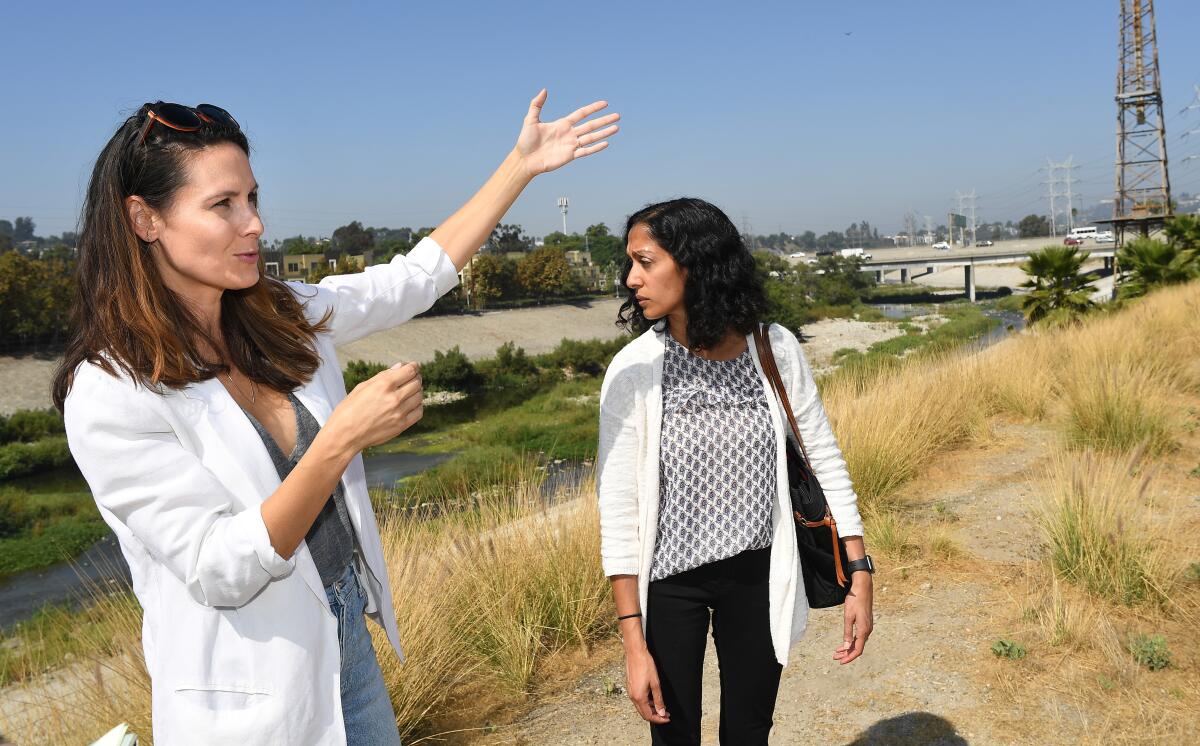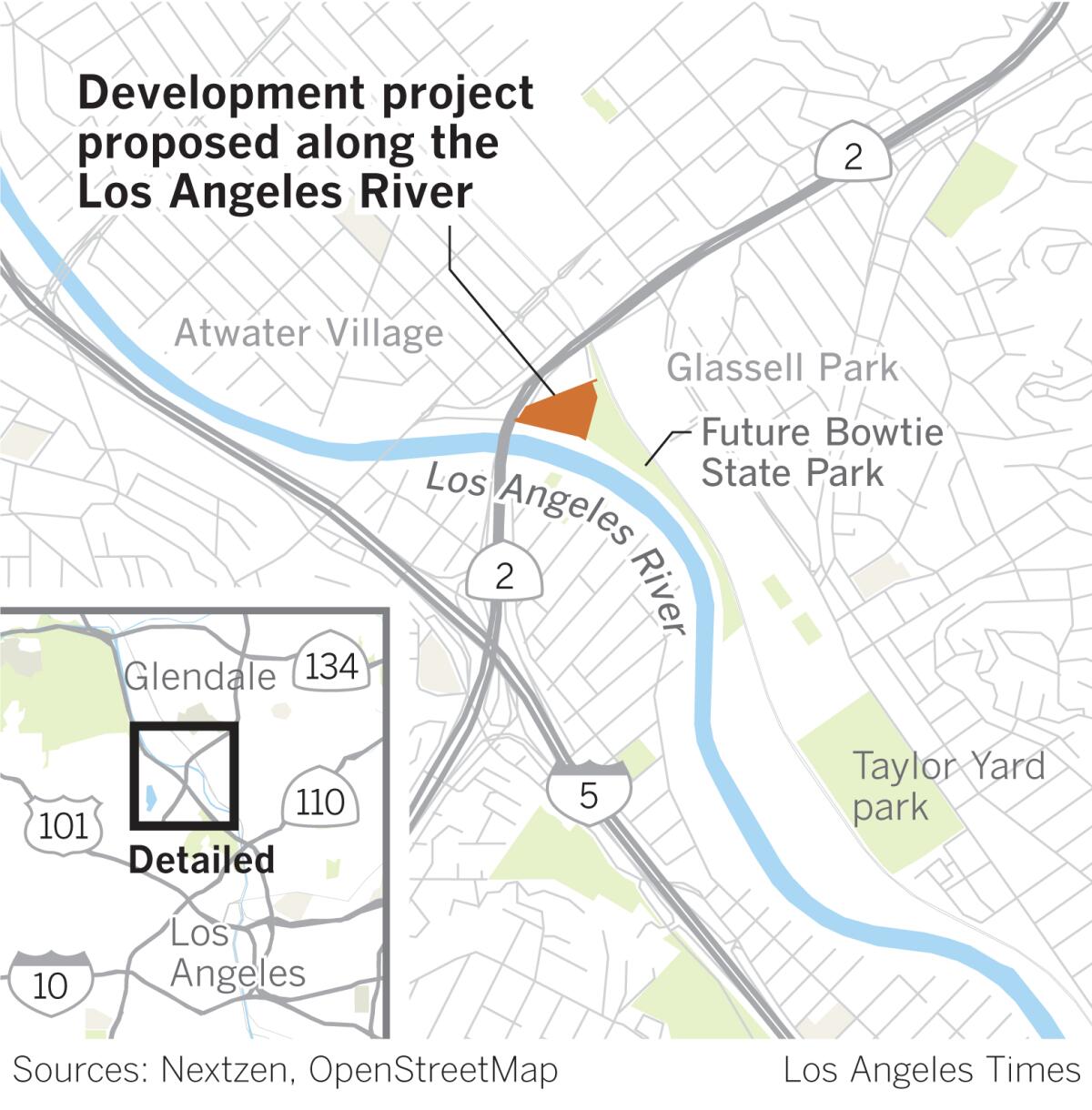Can Los Angeles blend new housing with river restoration? This is the first big test

- Share via
Los Angeles’s twin challenges of building more housing while restoring its namesake waterway are clashing along a shady 11-mile stretch of the Los Angeles River between downtown and the hills of Griffith Park.
On a 7-acre parcel in that stretch, a developer wants to build the riverfront’s first major development, Casitas Lofts, a 419-unit mix of mostly upscale apartments, offices and restaurants bordering neighborhoods on the east side of the river, Glassell Park and Atwater Village.
Proponents tout it as a potential gateway to the new Bowtie State Park and a catalyst for enlivening more of the river with snazzy development and bike trails. It would also result in the cleanup of an industrial site where Casitas Lofts would be constructed.

But opponents — including many nearby residents, the influential nonprofit Friends of the Los Angeles River and the Natural Resources Defense Council — contend the development would disrupt habitat restoration efforts, trigger gentrification and erode the area’s allure.
In particular, they fear the multi-story development could block access and overly commercialize the entrance to the Bowtie, a yet-to-be developed 18-acre parcel owned by California State Parks. It is adjacent to Rio de Los Angeles State Park and Taylor Yard, a 42-acre parcel the city acquired in 2017 for $60 million that is the heart of an ambitious L.A. River revitalization plan.
“Over my dead body will we see 419 apartment units go up at the entrance to a state park we fought so long and hard for,” said Julia Meltzer, founder of Clockshop, a nonprofit arts organization in an Elysian Valley neighborhood across the river from Glassell Park. She said the project would set a dangerous precedent by allowing a private developer to profit from decades of public planning and investment in river restoration, reflecting the desires of local communities.
Here’s a look at the preliminary plans for Taylor Yard, the former rail yard where the city of L.A. is starting its makeover of the L.A. River.
Gov. Gavin Newsom last month added a new wrinkle to the development debate, with his housing agency calling for Southern California cities and counties to plan for 1.3 million new homes in the next decade. The state’s decision would require construction of hundreds of thousands of new residences in Los Angeles County, where almost 59,000 people are without a permanent home.
Los Angeles City Councilman Gil Cedillo, whose district includes the 7-acre site, suggests there’s a lot to admire about the proposal, including that it “would be better than seeing a sewage treatment center built on that property.”
“The crux of the issue is this: We are in a housing crisis with more than 50,000 people sleeping in the street,” he said. “Now, a developer is coming forward with a plan to build colorful and bright new housing, clean up soil on the lot and improve public access to an adjacent state park at no cost to the city.”
Cedillo, however, agrees with critics who point out that with only 35 of its 419 units reserved as affordable housing for low-income households, Casitas Lofts will not make a noticeable difference in the county’s homeless problem.
The project has yet to receive full approvals. For now, the warring groups are waiting for a completed environmental impact review of the project expected later this year, officials said. Construction could begin within two years.
The environmental review will study the project’s impacts on traffic, air pollution, emergency response and public access, among other issues.
Helene Schpak of the Glassell Park Neighborhood Council’s planning and land use committee is among those who don’t want to see the area swallowed up by the project.
“We’re not NIMBYs. We just can’t imagine a worse proposal in a worse location,” she said. “The land they want to build on is critical to public access to a state park that reflects our needs for open space and access to the river — and it is in a flood plain.”
“Unfortunately,” she added, “big development proposals in Los Angeles tend to foreshadow gentrification, and low-income neighborhoods rarely survive it.”
Dana Sayles, a spokeswoman for the developer and owner of the site, Pan Am Equities, a New York equities firm, said reducing the size of the proposed project “is, at this point, not in our plan.”
The company, she said, is pursuing a zoning change because the property, which it purchased in 2016 for $22 million, is earmarked for heavy industrial uses. It is currently occupied by a company that designs and manufactures electronic products.
“The perception that Casitas Lofts will be exclusive and restrict access,” Sayles said, “is an opinion.”
State parks officials declined to comment pending completion of the environmental impact review, but Sayles said the company is working with state officials on improving access to Bowtie.
“We are going to create an incredible environment and community resource along the river that is designed to be complementary to the state park,” she said.
Pan Am Equities is owned by the Manocherian family, an influential mostly Manhattan-based real estate company founded by immigrants from Iran. At Casitas Lofts, the company envisions apartments in five-story buildings, with a 7-story garage serving as a buffer between the units and the freeway. Plans also call for 22,000 square feet of office and restaurant space, and a 42,000-square-foot “rooftop urban farm” atop the garage.
Despite that “green rooftop,” the project will add thousands of cars to the area and more hard surfaces to funnel stormwater into the river, impacts that will be analyzed in the environmental review.
Casitas Lofts focuses attention on how to anchor a new future for the L.A. River, which has gone through decades of transformations.
First it was the city’s main source of water. In the late 1930s, it was converted into a mostly concrete flood control channel 51 miles long and rimmed by industry, low-rent homes and businesses. In 2007, the city named it as an amenity in its master plan. In 2010, the U.S. Environmental Protection Agency deemed the river navigable and subject to the protections of the Clean Water Act, from Chatsworth to Long Beach.
In 2013, the U.S. Army Corps of Engineers recommended approval of an ambitious proposal to restore habitat, widen the river, create wetlands and provide access points and bike trails along the area.
Major development along the river is essential, urban planners say, to help pay for large-scale ecological restoration with city sales and property taxes the upgrades would generate.
But Jon Christensen, who serves on the board of directors of the nonprofit Los Angeles River State Park Partners, argues that Casitas Lofts won’t satisfy the city’s need “for more housing and equitable development” that provides tax revenue.
“It would take away from the possibilities for developing a world-class river restoration project and great parks on more than 100 acres along the river,” he said. “The city needs to step back and think carefully about who will benefit.”
Regardless of Casitas Lofts, developers are eyeing the riverfront as restaurants, professional offices and art studios move into the area. Rents are rising sharply, and speculators are buying up warehouses and vacant land.
“On my block, a property with a 1-bedroom, 1-bathroom house recently went on market for $1.3 million,” said David de la Torre, an Elysian Valley resident and neighborhood watch member.
He added that Pan Am wants to designate 35 units as affordable housing. “I’d be happy if he bumps that number up to about 200.”







